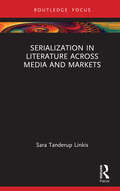- Table View
- List View
Serial Killers: Shocking True Stories of the World's Most Barbaric Murderers
by Jamie KingA gripping true crime compendium of some of the world's most infamous and shocking mass murderers, such as John Wayne Gacy, the Boston Strangler, the Moors murderers and Harold Shipman, as well as some lesser-known figures. This book not only relates the disturbing events that transpired but also delves into the psychology of the perpetrators.
Serial Killers: Jack the Ripper to The Zodiac Killer
by Lightning GuidesSerial Killers: Jack The Ripper to The Zodiac Killer is an exploration of the dark world of serial murder in the 20th and 21st century. Covering international cult figures from H.H. Holmes to Luis Garavito (La Beastia), examining psychological motivations of serial murderers, and presenting some of the most terrifying unsolved cases to date, Serial Killers provides an eerie peer into the oft uncovered world of murder and mystery.
Serial Killers: Death and Life in America's Wound Culture
by Mark SeltzerIn this provocative cultural study, the serial killer emerges as a central figure in what Mark Seltzer calls 'America's wound culture'. From the traumas displayed by talk show guests and political candidates, to the violent entertainment of Crash or The Alienist, to the latest terrible report of mass murder, we are surrounded by the accident from which we cannot avert our eyes. Bringing depth and shadow to our collective portrait of what a serial killer must be, Mark Seltzer draws upon popular sources, scholarly analyses, and the language of psychoanalysis to explore the genesis of this uniquely modern phenomenon. Revealed is a fascination with machines and technological reproduction, with the singular and the mass, with definitions of self, other, and intimacy. What emerges is a disturbing picture of how contemporary culture is haunted by technology and the instability of identity.
The Serial Killers: A Study in the Psychology of Violence
by Colin Wilson Donald SeamanAs the number of serial killers worldwide has risen steadily - from the emergence of Jack the Ripper in 1888 to Harold Shipman and Ivan Milat, the backpacker killer of the Australian outback - the need to understand mass murder is becoming more urgent. Using privileged access to the world's first National Centre for the Analysis of Violent Crime, Colin Wilson and Donald Seaman bring you this incisive study of the psychology of serial killers and the motives behind their crimes. From childhood traumas to issues of frustration, fear and fantasy, discover what turns an ordinary human being into a compulsive killer.
The Serial Killer's Apprentice
by Katherine Ramsland Tracy UllmanA psychological examination of the blurred line between victim and accomplice—and how a killer can be created Elmer Wayne Henley, Jr. was only fourteen when he first became entangled with serial rapist and murderer Dean Corll in 1971. Fellow Houston, Texas, teenager David Brooks had already been ensnared by the charming older man, bribed with cash to help lure boys to Corll’s home. When Henley unwittingly entered the trap, Corll evidently sensed he’d be of more use as a second accomplice than another victim. He baited Henley with the same deal he’d given Brooks: $200 for each boy they could bring him. Henley didn’t understand the full extent of what he had signed up for at first. But once he started, Corll convinced him that he had crossed the line of no return and had to not only procure boys but help kill them and dispose of the bodies, as well. When Henley first took a life, he lost his moral base. He felt doomed. By the time he was seventeen, he’d helped with multiple murders and believed he’d be killed, too. But on August 8, 1973, he picked up a gun and shot Corll. When he turned himself in, Henley showed police where he and Brooks had buried Corll’s victims in mass graves. Twenty-eight bodies were recovered—most of them boys from Henley’s neighborhood—making this the worst case of serial murder in America at the time. The case reveals gross failures in the way cops handled parents’ pleas to look for their missing sons and how law enforcement possibly protected a larger conspiracy. The Serial Killer’s Apprentice tells the story of Corll and his accomplices in its fullest form to date. It also explores the concept of “mur-dar” (the predator’s instinct for exploitable kids), current neuroscience about adolescent brain vulnerabilities, the role of compartmentalization, the dynamic of a murder apprenticeship, and how tales like Henley’s can aid with early intervention. Despite his youth and cooperation, Henley went to trial and received six life sentences. He’s now sixty-five and has a sense of perspective about how adult predators can turn formerly good kids into criminals. Unexpectedly, he’s willing to talk. This book is his warning and the story of the unspeakable evil and sorrow that befell Houston in the early 1970s.
Serial Killers & Mass Murderers: Profiles of the World's Most Barbaric Criminals
by Nigel CawthorneShocking true stories of the world’s most notorious criminals from the author of Prince Andrew: Epstein, Maxwell and the Palace.Serial Killers & Mass Murderers takes you into the minds of the criminals who committed the world’s most notorious and horrifying crimes. Each of the sadistic murderers profiled here was once known simply as someone’s neighbor, co-worker or child. What turned them into killers? In one chilling chapter after another, this book profiles a terrifying succession of homicidal maniacs and asks the question, “What makes them tick?”Through the pages of this haunting book, you’ll delve into the psyches of . . . Jeffrey DahmerThe Zodiac KillerDr. Harold ShipmanSon of SamThe Columbine KillersCharles MansonThe Night StalkerThe Yorkshire RipperTed BundyCharles StarkweatherThe Boston StranglerAnd more“The refrigerator contained meat, including a human heart, in plastic bags. There were three human heads in the freezer. Two more skulls were found in a pot on the stove. Another pot contained male genital organs and severed heads, and there were the remains of three male torsos in the trash.”
Serial Killing on Screen: Adaptation, True Crime and Popular Culture (Palgrave Studies in Crime, Media and Culture)
by Sarah E. Fanning Claire O’CallaghanThis book explores the representation of real-life serial murders as adapted for the screen and popular culture. Bringing together a selection of essays from international scholars, Serial Killing on Screen: Adaptation, True Crime and Popular Culture examines the ways in which the screen has become a crucial site through which the most troubling of real-life crimes are represented, (re)constructed and made accessible to the public. Situated at the nexus of film and screen studies, theatre studies, cultural studies, criminology and sociology, this interdisciplinary collection raises questions about, and implications for, thinking about the adaptation and representation of true crime in popular culture, and the ideologies at stake in such narratives. It discusses the ways in which the adaptation of real-life serial murder intersects with other markers of cultural identity (gender, race, class, disability), as well as aspects of criminology (offenders, victims, policing, and profiling) and psychology (psychopathy, sociopathy, and paraphilia). This collection is unique in its combined focus on the adaptation of crimes committed by real-life criminal figures who have gained international notoriety for their plural offences, including, for example, Ted Bundy, Ian Brady and Myra Hindley, Aileen Wuornos, Jack the Ripper, and the Zodiac, and for situating the tales of these crimes and their victims’ stories within the field of adaptation studies.
Serial Mexico: Storytelling Across Media, From Nationhood to Now (Critical Mexican Studies)
by Amy E. WrightNo book until now has tied in two centuries of Mexican serial narratives—tales of glory, of fame, and of epic characters, grounded in oral folklore—with their subsequent retelling in comics, radio, and television soap operas. Wright&’s multidisciplinary Serial Mexico delves into this storytelling tradition: examining the nostalgic tales reimagined in novelas, radionovelas, telenovelas and onwards, and examining the foundational figures who have been woven into society. This panorama shows the Mexican experience of storytelling from the country&’s early days until now, showcasing protagonists that mock authority, make light of hierarchy, and embrace the hybridity and mestizaje of Mexico. These tales reflect on and respond to crucial cultural concerns such as family, patriarchy, gender roles, racial mixing, urbanization, modernization, and political idealism. Serial Mexico thus examines how serialized storytelling&’s melodrama and sensationalism reveals key political and cultural messaging. In a detailed yet accessible style, Wright describes how these stories have continued to morph with current times&’ concerns and social media. Will tropes and traditions carry on in new and reimagined serial storytelling forms? Only time will tell. Stay tuned for the next episode.
Serial Murder: Modern Scientific Perspectives (The\international Library Of Criminology, Criminal Justice And Penology Ser.)
by Elliott LeytonThis title was first published in 2000: Few areas of criminal activity have sustained such widely held attention as serial murder. This volume charts the complete progress of academic work in this field, detailing the development from the early domination of psychiatric enquiries to the later proliferation of criminal justice studies into the darkest of human behaviours.
Serial Selves: Identity and Representation in Autobiographical Comics
by Frederik KøhlertAutobiography is one of the most dynamic and quickly-growing genres in contemporary comics and graphic narratives. In Serial Selves, Frederik Byrn Køhlert examines the genre’s potential for representing lives and perspectives that have been socially marginalized or excluded. With a focus on the comics form’s ability to produce alternative and challenging autobiographical narratives, thematic chapters investigate the work of artists writing from perspectives of marginality including gender, sexuality, disability, and race, as well as trauma. Interdisciplinary in scope and attuned to theories and methods from both literary and visual studies, the book provides detailed formal analysis to show that the highly personal and hand-drawn aesthetics of comics can help artists push against established narrative and visual conventions, and in the process invent new ways of seeing and being seen. As the first comparative study of how comics artists from a wide range of backgrounds use the form to write and draw themselves into cultural visibility, Serial Selves will be of interest to anyone interested in the current boom in autobiographical comics, as well as issues of representation in comics and visual culture more broadly.
The Serial Verb Construction Parameter (Outstanding Dissertations in Linguistics)
by Osamuyimen Thompson StewartAn investigation of the serial verb construction, this work engages central issues in syntactic theory-complex predicates, clausal architecture and syntactic variation.
Seriality and Texts for Young People: The Compulsion to Repeat (Critical Approaches to Children's Literature)
by Melanie Dennis Unrau M. Reimer N. Ali D. England M. Dennis UnrauSeriality and Texts for Young People is a collection of thirteen scholarly essays about series and serial texts directed to children and youth, each of which begins from the premise that a basic principle of seriality is repetition.
Serialization in Literature Across Media and Markets
by Sara Tanderup LinkisSerialization is an old narrative strategy and a form of publication that can be traced far back in literary history, yet serial narratives are as popular as ever. This book investigates a resurgence of serial narratives in contemporary literary culture. Analyzing series as diverse as Mark Z. Danielewski’s experimental book series The Familiar; audiobook series by the Swedish streaming service Storytel; children’s books by Lemony Snicket and Philip Pullman and their adaptations into screen; and serial writing and reading on the writing site Wattpad, the book traces how contemporary series at once are shaped by literary tradition and develop the format according to the logics of new media and digital technologies. The book sheds light on the interplay between the selected serials' narrative content and medial, social, and economic contexts, drawing on insights from literary studies, literary sociology, media studies, and cultural studies. Serialization in Literature Across Media and Markets thus contributes a unique and interdisciplinary perspective on a historical phenomenon that has proved ever more successful in contemporary media culture. It is a book for researchers and students of literature and media and for anyone who likes a good series and wants to understand why.
Serialization in Popular Culture (Routledge Research in Cultural and Media Studies)
by Rob Allen Thijs van den BergFrom prime-time television shows and graphic novels to the development of computer game expansion packs, the recent explosion of popular serials has provoked renewed interest in the history and economics of serialization, as well as the impact of this cultural form on readers, viewers, and gamers. In this volume, contributors—literary scholars, media theorists, and specialists in comics, graphic novels, and digital culture—examine the economic, narratological, and social effects of serials from the nineteenth to the twenty-first century and offer some predictions of where the form will go from here.
Serienfragmente
by Vincent Fröhlich Sophie G. Einwächter Maren Scheurer Vera Cuntz-LengDer Band ist ein erstes Übersichtswerk zu vorzeitig abgesetzten oder längerfristig unterbrochenen Fernsehserien. Er analysiert diese im Hinblick auf ihren Fragmentstatus und erprobt Ansätze, wie mit diesem umgegangen werden kann: Das Spektrum reicht von essayistischen Perspektiven bis zu Beobachtungen aus der ethnologischen Feldforschung; Fan Studies, Serialitätsstudien, philosophische Betrachtungen kommen ebenso zum Tragen wie Analysen, die Fragmenttheorien aus der Architektur und Fotografie hinzuziehen. Der Begriff und der Eigenwert des Fragments werden damit erstmals im Kontext der Fernsehserie anhand zahlreicher Beispiele diskutiert.
Serious Adverse Events: An Uncensored History of AIDS
by Celia Farber“Farber [is] a lucid and courageous witness to the power-play behind the first ‘scamdemic,’ . . . [Her] work is journalism at its best—solid, lucid, and humane, attacking wrongs that few dare touch, and thereby helping right them.” —Mark Crispin Miller, bestselling author and professor of media studies at NYU On April 23, 1984, in a packed press conference room in Washington, DC, the secretary of health and human services declared, “The probable cause of AIDS has been found.” By the next day, “probable” had fallen away, and the novel retrovirus later named HIV became forever lodged in global consciousness as “the AIDS virus.” Celia Farber, then an intrepid young reporter for SPIN magazine, was the only journalist to question the official narrative and dig into the science of AIDS. She reported on the “evidence” that was being continually cited and repeated by health officials and the press, the deadliness of AZT, and Dr. Fauci’s trials on children, infants, and pregnant mothers. Throughout, Faber’s reportage was largely ignored. She was maligned, maliciously attacked, and ultimately canceled. Now, forty years after her original reporting, Farber’s Serious Adverse Events: An Uncensored History of AIDS is reissued with a new foreword by Mark Crispin Miller, shining much-needed light on her groundbreaking work once again. More relevant than ever, this book serves as an essential foundation to understanding its catastrophic sequel: COVID-19. Serious Adverse Events makes clear that the tactics employed at the height of HIV/AIDS—the fearmongering, cancel culture, and “woke” takeover of science, medicine, and journalism—persist today. The response to COVID-19 isn’t new: it is a well-trod and dangerous path in the social landscape. “Groundbreaking work.”—Bob Guccione, Jr., founder of SPIN magazine "Farber’s research give context to the Covid catastrophe which she all but predicted. Despite the medical cartel’s brutal crusade to silence and vilify her, Farber never compromised. . . I’m happy she has lived to experience her own utter vindication. I also love her writing style."—Robert F. Kennedy Jr.
Serious and Violent Juvenile Offenders: Risk Factors and Successful Interventions
by Dr Rolf Loeber Professor David P. FarringtonDetailed and comprehensive, this volume presents authoritative discussions by leading scholars on issues surrounding serious and violent juvenile offenders. This population is responsible for a disproportionate percentage of all crime and poses the greatest challenge to juvenile justice policymakers. This volume integrates knowledge about risk and protective prevention programs, so that conclusions from each area can inform the other.
Serious Games: Mechanisms and Effects
by Ritterfeld Ute Cody Michael Peter VordererSerious Games provides a thorough exploration of the claim that playing games can provide learning that is deep, sustained and transferable to the real world. "Serious games" is defined herein as any form of interactive computer-based game software for one or multiple players to be used on any platform and that has been developed to provide more than entertainment to players. With this volume, the editors address the gap in exisiting scholarship on gaming, providing an academic overview on the mechanisms and effects of serious games. Contributors investigate the psychological mechanisms that take place not only during gaming, but also in game selection, persistent play, and gaming impact. The work in this collection focuses on the desirable outcomes of digital game play. The editors distinguish between three possible effects -- learning, development, and change -- covering a broad range of serious games’ potential impact. Contributions from internationally recognized scholars focus on five objectives: Define the area of serious games Elaborate on the underlying theories that explain suggested psychological mechanisms elicited through serious game play, addressing cognitive, affective and social processes Summarize the empirical evidence on the effectiveness of serious games, Introduce innovative research methods as a response to methodological challenges imposed through interactive media Discuss the possibilities and limitations of selected applications for educational purposes. Anchored primarily in social science research, the reader will be introduced to approaches that focus on the gaming process and the users’ experiences. Additional perspectives will be provided in the concluding chapters, written from non-social science approaches by experts in academic game design and representatives of the gaming industry. The editors acknowledge the necessity for a broader interdisciplinary study of the phenomena and work to overcome the methodological divide in games research to look ahead to a more integrated and interdisciplinary study of digital games. This timely and singular volume will appeal to scholars, researchers, and graduate students working in media entertainment and game studies in the areas of education, media, communication, and psychology.
Serious Games for Enhancing Law Enforcement Agencies: From Virtual Reality to Augmented Reality (Security Informatics and Law Enforcement)
by Babak AkhgarThis book provides a comprehensive and practically minded introduction into serious games for law enforcement agencies. Serious games offer wide ranging benefits for law enforcement with applications from professional trainings to command-level decision making to the preparation for crises events. This book explains the conceptual foundations of virtual and augmented reality, gamification and simulation. It further offers practical guidance on the process of serious games development from user requirements elicitation to evaluation. The chapters are intended to provide principles, as well as hands-on knowledge to plan, design, test and apply serious games successfully in a law enforcement environment. A diverse set of case studies showcases the enormous variety that is possible in serious game designs and application areas and offers insights into concrete design decisions, design processes, benefits and challenges. The book is meant for law enforcement professionals interested in commissioning their own serious games as well as game designers interested in collaborative pedagogy and serious games for the law enforcement and security sector.
Serious Leisure: A Perspective for Our Time (Leisure Studies In A Global Era Ser.)
by David.B SachsmanSerious Leisure offers a comprehensive view and analysis of the current state of the sociology of leisure. Defining and differentiating the way people use their free time, Robert A. Stebbins divides such activity into categories of serious (skilled), casual (unskilled), and project-based (short-term) leisure that he further separates into a variety of types and subtypes. Together they comprise what he calls the serious leisure perspective. Stebbins sets out the basic concepts that make up the three leisure forms, focusing on their essential elements.Stebbins sees serious leisure realized by way of a set of foundational concepts—organization, community, history, lifestyle, and culture. He reviews the history and background of the concept of serious leisure and follows up with historical commentary. Finally, he examines the future and the importance of the serious leisure perspective in a globalizing world, and some of its critical links with other fields of knowledge and practice, notably the nonprofit sector and preventive medicine.Serious Leisure is a coherent and comprehensive resource setting out the main parameters of what is now widely recognized as an interdisciplinary research area. It will be of interest to sociologists, labor studies specialists, and economists.
Serious Leisure and Nature
by Lee Davidson Robert A. StebbinsOutings in nature considered as leisure activity constitute a main way in which many people the world over presently use their free time. Nature is defined here as any natural setting perceived by users as at most only minimally modified by human beings. In its most general manifestation nature thus defined is composed of one or more of six elements: air, land, water, plants, animals (birds, fish) and snow or ice. Outdoor pursuits are immensely popular, especially among city dwellers. They are also widely discussed in leisure studies, where they have inspired considerable research. Still this research tends to lack a theoretic anchor, which this book provides through the new serious leisure concept of nature challenge activity (NCA). It examines several hundred NCAs and types of NCAs, setting out how meeting this challenge unfolds in an aesthetically appealing natural environment with notable implications for consumption and environmental sustainability.
Serious Money: Walking Plutocratic London
by Caroline Knowles'A latter-day Canterbury Tales ... Serious Money has a serious mission' The Times'Eye-opening ... part guide, part indictment of a yawning wealth gap' Misha Glenny, Financial TimesLondon is a plutocrat's paradise, with more resident billionaires than New York, Hong Kong or Moscow. Far from trickling down, their wealth is burning up the environment and swallowing up the city. But what do we really know about London's super rich, and the lives they lead?To find out more about this secretive elite, sociologist Caroline Knowles walks the streets of London from the City to suburban Surrey. Her walks reveal how the wealthy shape the capital in their image, creating a new world of gated communities and luxury developments. Along the way we meet a wide and wickedly entertaining cast of millionaires, billionaires and those who serve them: bankers, tech tycoons, Conservative party donors, butlers, bodyguards, divorce lawyers and many more.By turns jaw-dropping, enraging and enlightening, Serious Money explodes the fiction that wealth is a condition to aspire to, revealing the isolation and paranoia which accompany it when the plutocrat's recompense - a life of unlimited luxury - ultimately proves hollow. It is a powerful reminder that it is not just the super-rich who get to make the city: we make it too, and could demand something different. Because serious money is good for no one - not even the rich.'An eye-opening, deeply disturbing, fast-moving journey through the lives, homes and affairs of the filthy rich of London' Danny Dorling, author of All That Is Solid'A wonderful and vital account of a city ruled by, and for, extreme wealth' Anna Minton, author of Big Capital
Serious Nonsense: Groundhog Lodges, Versammlinge, and Pennsylvania German Heritage (Keystone Books)
by William W. DonnerVersammlinge—community events filled with songs, performances, speeches, and skits that celebrate Pennsylvania German heritage and culture—are held entirely in the Pennsylvania German Deitsch language. Some, the “groundhog lodges,” feature a ceremony honoring the groundhog, while others do not. These unique meetings, expressions of a distinctive ethnic identity in the context of a rapidly changing society, have become a traditional mainstay among Pennsylvania Germans who have worked to preserve their language and culture into the twenty-first century. Serious Nonsense introduces readers to Pennsylvania German cultural practices that tourists rarely see and that outsiders, including most scholars, rarely learn about. The book explores the origins of the versammlinge and details the practice’s significance since the 1930s, when the first meetings of the Pennsylvania German groundhog lodges were held. Much as they did then, versammlinge today follow a pattern of prayers, patriotism, and speeches extolling values associated with Pennsylvania German identity, as well as theatrical and oral events that humorously contrast a simpler past with a more complex and confusing present. And the groundhog lodges feature one Pennsylvania German tradition that has become familiar in popular culture: groundhog weather prognostication.
Serious Nonsense: Groundhog Lodges, Versammlinge, and Pennsylvania German Heritage (Keystone Books)
by William W. DonnerVersammlinge—community events filled with songs, performances, speeches, and skits that celebrate Pennsylvania German heritage and culture—are held entirely in the Pennsylvania German Deitsch language. Some, the “groundhog lodges,” feature a ceremony honoring the groundhog, while others do not. These unique meetings, expressions of a distinctive ethnic identity in the context of a rapidly changing society, have become a traditional mainstay among Pennsylvania Germans who have worked to preserve their language and culture into the twenty-first century. Serious Nonsense introduces readers to Pennsylvania German cultural practices that tourists rarely see and that outsiders, including most scholars, rarely learn about. The book explores the origins of the versammlinge and details the practice’s significance since the 1930s, when the first meetings of the Pennsylvania German groundhog lodges were held. Much as they did then, versammlinge today follow a pattern of prayers, patriotism, and speeches extolling values associated with Pennsylvania German identity, as well as theatrical and oral events that humorously contrast a simpler past with a more complex and confusing present. And the groundhog lodges feature one Pennsylvania German tradition that has become familiar in popular culture: groundhog weather prognostication.
A Serious Proposal To The Ladies (Broadview Editions)
by Mary Astell Patricia SpringborgMary Astell’s A Serious Proposal to the Ladies is one of the most important and neglected works advocating the establishment of women’s academies. Its reception was so controversial that Astell responded with a lengthy sequel, also in this volume. The cause of great notoriety, Astell’s Proposal was imitated by Defoe in his “An Academy for Women,” parodied in the Tatler, satirized on the stage, plagiarized by Bishop Berkeley, and later mocked by Gilbert and Sullivan in Princess Ida.























